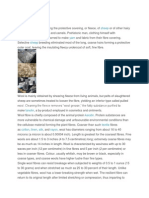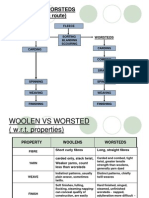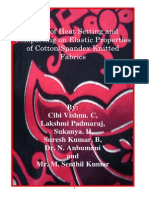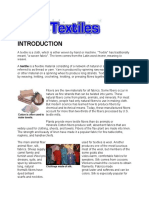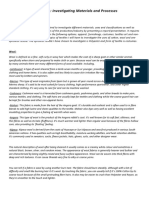Fiber,: Also Spelled Materials Thread Biology Plants Animals Tissues Filaments String Rope Composite Materials Paper Felt
Fiber,: Also Spelled Materials Thread Biology Plants Animals Tissues Filaments String Rope Composite Materials Paper Felt
Uploaded by
ganeshaniitdCopyright:
Available Formats
Fiber,: Also Spelled Materials Thread Biology Plants Animals Tissues Filaments String Rope Composite Materials Paper Felt
Fiber,: Also Spelled Materials Thread Biology Plants Animals Tissues Filaments String Rope Composite Materials Paper Felt
Uploaded by
ganeshaniitdOriginal Title
Copyright
Available Formats
Share this document
Did you find this document useful?
Is this content inappropriate?
Copyright:
Available Formats
Fiber,: Also Spelled Materials Thread Biology Plants Animals Tissues Filaments String Rope Composite Materials Paper Felt
Fiber,: Also Spelled Materials Thread Biology Plants Animals Tissues Filaments String Rope Composite Materials Paper Felt
Uploaded by
ganeshaniitdCopyright:
Available Formats
Fiber, also spelled fibre, is a class of materials that are continuous filaments or are in discrete elongated pieces, similar
to lengths of thread. They are very important in the biology of both plants and animals, for holding tissues together.
Human uses for fibers are diverse. They can be spun into filaments, string or rope, used as a component of composite
materials, or matted into sheets to make products such as paper or felt. Fibers are often used in the manufacture of other
materials. Synthetic fibers can be produced very cheaply and in large amounts compared to natural fibers, but natural
fibers enjoy some benefits, such as comfort, over their man-made counterparts.
A thread is a kind of thin yarn used for sewing.
Water content or moisture content is the quantity of water contained in a material, such as soil (called soil moisture),
rock, ceramics, or wood on a volumetric or gravimetric basis. The property is used in a wide range of scientific and
technical areas, and is expressed as a ratio, which can range from 0 (completely dry) to the value of the materials'
porosity at saturation.
Fibers can be naturally occurring – in the form of plants and animals – or derived from other sources. The former variety
is termed natural fiber and the latter, man-made fibers.
• Natural Fibers
Natural fibers are those fibers that are directly from nature, usually from plants or animals. The common natural
fibers are cotton, wool, silk, jute, and flax/linen.
• Wool
Wool is the dense and soft hair derived from the coat of sheep and certain other mammals. For industrial
purposes the fiber of the camel, alpaca, Angora goat, llama, Kashmir goat (the fiber is called cashmere), and
vicuña is classed as wool.
Wool is primarily used in apparel that is intended to keep us warm, because the woolen fibers are non-
conductors of heat and its crimps capture and enmesh the thin air.
Cotton
Cotton is perhaps the most commonly used natural fiber. Derived from the cotton plant which belongs to the
same family as do plants such as hibiscus and okra, the fiber is both economical as well as effective. The
cotton plant is known to have been grown in India over 5000 years ago, and perhaps existed even much before
that.
• Silk
Silk is the soft and shiny fiber that is used in a variety of luxury textiles. By a process known as sericulture,
silk is obtained from the cocoon of the silkworm larva. The shiny appearance of silk comes from the fibres'
triangular prism-like structure, owing to which the fabric refracts light at different angles.
Relative humidity is defined as the ratio of the partial pressure of water vapor in a gaseous mixture of air and water
vapor to the saturated vapor pressure of water at a given temperature. Relative humidity is expressed as a percentage and
is calculated in the following manner:
where
is the partial pressure of water vapor in the gas mixture;
is the saturation vapor pressure of water at the temperature of the gas mixture; and
is the relative humidity of the gas mixture being considered.
Relative humidity is often mentioned in weather forecasts and reports, as it is an indicator of the likelihood of
precipitation, dew, or fog. In hot summer weather, it also increases the apparent temperature to humans (and other
animals) by hindering the evaporation of perspiration from the skin as the relative humidity rises.
Absolute humidity is the quantity of water in a particular volume of air. The most common units are grams per cubic
meter, although any mass unit and any volume unit could be used. Pounds per cubic foot are common in the U.S., and
occasionally even other units mixing the Imperial and metric systems are used.
If all the water in one cubic meter of air were condensed into a container, the container could be weighed to determine
absolute humidity. The amount of vapor in that cube of air is the absolute humidity of that cubic meter of air. More
technically: the mass of water vapor mw, per cubic meter of air, Va .
You might also like
- GPA 2140 - Liquefied Petroleum Gas Specifications and Test MethodsDocument56 pagesGPA 2140 - Liquefied Petroleum Gas Specifications and Test Methodsclementer92% (12)
- Organic Bamboo FiberDocument14 pagesOrganic Bamboo FiberNaimul HasanNo ratings yet
- fx-991EX Quick Reference Guide PDFDocument48 pagesfx-991EX Quick Reference Guide PDFSblNo ratings yet
- Boiler EfficiencyDocument12 pagesBoiler Efficiencyswaroop351No ratings yet
- Wool FibreDocument2 pagesWool FibreSourav Behera100% (1)
- 1.5 Flax & LinenDocument10 pages1.5 Flax & LinenKAWSER RAFINo ratings yet
- Clothing ComfortDocument23 pagesClothing Comfortsyed rasheedNo ratings yet
- Knowing Textile - Present 4Document48 pagesKnowing Textile - Present 4Aisya IsaisNo ratings yet
- Investigating An Appropriate Temperature For Heat Setting in A Stentermachine To Control The Stretch and Growth of A Cotton Spande 2165 8064 1000319Document9 pagesInvestigating An Appropriate Temperature For Heat Setting in A Stentermachine To Control The Stretch and Growth of A Cotton Spande 2165 8064 1000319Robiul AlamNo ratings yet
- Unit 4-Cotton PDFDocument25 pagesUnit 4-Cotton PDFFuad HamidNo ratings yet
- WoolDocument88 pagesWoolRoha Roha100% (1)
- A Training Report ON Meter & Shrinkage Variation From Grey To Finish AT Anubha Industries Private LimitedDocument34 pagesA Training Report ON Meter & Shrinkage Variation From Grey To Finish AT Anubha Industries Private LimitedSK AzaharuddinNo ratings yet
- The Waste Management of TextileDocument10 pagesThe Waste Management of TextiledaabgchiNo ratings yet
- Rope DyeingDocument48 pagesRope DyeingAqeel AhmedNo ratings yet
- Effects of Different Pretreatment Processes On Viscose Fabrics in Different Types and PropertiesDocument10 pagesEffects of Different Pretreatment Processes On Viscose Fabrics in Different Types and PropertiesFathi MustafaNo ratings yet
- Bamboo Fabric DyeingDocument31 pagesBamboo Fabric DyeingSayed Mehdi Shah KazmiNo ratings yet
- Assignment On: Identification of Textile FibersDocument42 pagesAssignment On: Identification of Textile Fibersvivek jangraNo ratings yet
- A Glossary of Ecological TermsDocument111 pagesA Glossary of Ecological TermsMeiardhy MujiantoNo ratings yet
- FLAXDocument13 pagesFLAXkavi RAJ SenNo ratings yet
- As 1818-1976 Flax Canvas Including Water-Bag CanvasDocument5 pagesAs 1818-1976 Flax Canvas Including Water-Bag CanvasSAI Global - APACNo ratings yet
- Cleavage of Structural Proteins During The Assembly of The Head of Bacteriophage T4Document6 pagesCleavage of Structural Proteins During The Assembly of The Head of Bacteriophage T4Ergo SumNo ratings yet
- CottonDocument84 pagesCottonMD.MAHABUB ALOM REFAETNo ratings yet
- User Manual S-900-1200-1500Document49 pagesUser Manual S-900-1200-1500arimudaNo ratings yet
- Introduction To Nylon FibreDocument3 pagesIntroduction To Nylon FibreDebasish GhoshNo ratings yet
- ADVISE ON WASHING/DRYING - Before Using The Garments!Document1 pageADVISE ON WASHING/DRYING - Before Using The Garments!arkcgemNo ratings yet
- Renewable Energy Resources: Textile ProcessingDocument17 pagesRenewable Energy Resources: Textile ProcessingrohithNo ratings yet
- Alkaline Weight ReductionDocument1 pageAlkaline Weight Reductionsateeshgore100% (2)
- Mosquito Repellent Finish of Cotton Fabric by Extracting Castor OilDocument6 pagesMosquito Repellent Finish of Cotton Fabric by Extracting Castor OilTRUSHA PITHADIYANo ratings yet
- Tencel FiberDocument21 pagesTencel FiberImran KhanNo ratings yet
- Genetic Manipulation in Plants: Assoc. Prof. Dr. Asmah Awal Faculty of Plantation & Agrotechnology Asmah138@uitm - Edu.myDocument31 pagesGenetic Manipulation in Plants: Assoc. Prof. Dr. Asmah Awal Faculty of Plantation & Agrotechnology Asmah138@uitm - Edu.myXwag 12No ratings yet
- Classification of Dyeing & Vat DyesDocument12 pagesClassification of Dyeing & Vat DyesChandni GuptaNo ratings yet
- Effect of Heat Setting and Compacting On Elastic Properties of Cotton/Spandex Knitted FabricsDocument13 pagesEffect of Heat Setting and Compacting On Elastic Properties of Cotton/Spandex Knitted Fabricsziz00No ratings yet
- Organic Grain Grower: Jack LazorDocument5 pagesOrganic Grain Grower: Jack LazorChelsea Green PublishingNo ratings yet
- Lecture Three Natural Bast FiberDocument46 pagesLecture Three Natural Bast FiberGemeda GebinoNo ratings yet
- Investigation of Air Permeability of Cotton & Modal Knitted FabricsDocument6 pagesInvestigation of Air Permeability of Cotton & Modal Knitted FabricsAhmad SamerNo ratings yet
- Presentation On Swelling of Textile MaterialsDocument13 pagesPresentation On Swelling of Textile MaterialsNazmul HasanNo ratings yet
- Textile Fiber Intro PDFDocument30 pagesTextile Fiber Intro PDFmoorthy_sweety43075% (8)
- FIBERDocument9 pagesFIBERnaivaanNo ratings yet
- 79 1 ET V1 S1 - Unit - 1 PDFDocument14 pages79 1 ET V1 S1 - Unit - 1 PDFvandana upadhyayNo ratings yet
- TextileDocument6 pagesTextileBilla DamamiNo ratings yet
- 03.2 The Wool Fibre and Its Applications NotesDocument34 pages03.2 The Wool Fibre and Its Applications Notesatwijukye raymondNo ratings yet
- Knitting Assignment-Types of TextilesDocument32 pagesKnitting Assignment-Types of TextilesOwaiste50% (2)
- Origin of FibreDocument10 pagesOrigin of FibreShyam ParthasarathyNo ratings yet
- Textiles Research TaskDocument8 pagesTextiles Research TaskKalleeNo ratings yet
- Textile 1Document118 pagesTextile 1Alina EneNo ratings yet
- Types of Textile IndustryDocument4 pagesTypes of Textile IndustryJanet Paletta100% (2)
- Textile - WikipediaDocument58 pagesTextile - WikipediaNani100% (1)
- Уроки Для 2ДЗ (2 Курс Дизайнери) 2Document31 pagesУроки Для 2ДЗ (2 Курс Дизайнери) 2Katia LeliakhNo ratings yet
- Study On Textile FibersDocument9 pagesStudy On Textile FibersAbid hasanNo ratings yet
- Textile - WikipediaDocument10 pagesTextile - WikipediaMohsin KhanNo ratings yet
- Properties Natural FibresDocument46 pagesProperties Natural FibresanishaNo ratings yet
- FibresDocument2 pagesFibressanjaydhanwariaNo ratings yet
- Unconventional Fibre PlantsDocument18 pagesUnconventional Fibre PlantsRajendra Singh MeenaNo ratings yet
- Cta Properties PDFDocument20 pagesCta Properties PDFAlen Jose ThomasNo ratings yet
- TDT 151 Lecture Notes 2022Document44 pagesTDT 151 Lecture Notes 2022Ollè WorldwideNo ratings yet
- Classification of FibresDocument12 pagesClassification of FibresARYAN RATHORENo ratings yet
- What Are Natural FibersDocument2 pagesWhat Are Natural FibersCathy BiasettiNo ratings yet
- 10 Different Types of Natural Fabrics - Sahni FabsDocument10 pages10 Different Types of Natural Fabrics - Sahni FabsFadzai Stephanie PatsikaNo ratings yet
- Relations Between Fiber Structure and PropertiesDocument7 pagesRelations Between Fiber Structure and PropertiesChikam BuraNo ratings yet
- Importance of Fibers in Textiles: Kavitha RajanDocument44 pagesImportance of Fibers in Textiles: Kavitha RajankavineshpraneetaNo ratings yet
- Scheme of The EvaluationDocument6 pagesScheme of The EvaluationSabihanaz InamdarNo ratings yet
- SUNI - Classification and Types of Clothing FibersDocument32 pagesSUNI - Classification and Types of Clothing FibersJoseph MontainNo ratings yet
- Textile Industry - 01 LectureDocument40 pagesTextile Industry - 01 Lectureisabelism100% (1)
- SHRACHI 9D6+ Multi-Functional Diesel Power Weeder - Leaflet EnglishDocument2 pagesSHRACHI 9D6+ Multi-Functional Diesel Power Weeder - Leaflet EnglishganeshaniitdNo ratings yet
- File Good Habits For Kids 1613396627Document10 pagesFile Good Habits For Kids 1613396627ganeshaniitdNo ratings yet
- SHRACHI 7P3 Petrol Power Weeder - Leaflet EnglishDocument2 pagesSHRACHI 7P3 Petrol Power Weeder - Leaflet EnglishganeshaniitdNo ratings yet
- Book 1Document1 pageBook 1ganeshaniitdNo ratings yet
- Sewing Threads From Polyester Staple FibreDocument13 pagesSewing Threads From Polyester Staple FibreganeshaniitdNo ratings yet
- FibresDocument78 pagesFibresnitishkohli100% (1)
- IEEE Transactions, Journals, and Letters - Information For AuthorsDocument27 pagesIEEE Transactions, Journals, and Letters - Information For Authorsratio_rockNo ratings yet
- Vacuum Pumps - CatalogDocument8 pagesVacuum Pumps - Catalogdéborah_rosalesNo ratings yet
- Digitrex DSC-3500Z Digital Camera User ManualDocument54 pagesDigitrex DSC-3500Z Digital Camera User Manualjluther456No ratings yet
- Lincoln Laser PolygonsTech Paper 2 17 2015 PDFDocument35 pagesLincoln Laser PolygonsTech Paper 2 17 2015 PDFAndrei TaranuNo ratings yet
- Electrical StudentDocument2 pagesElectrical StudentNoel BrhaneNo ratings yet
- اعطال شارب PDFDocument13 pagesاعطال شارب PDFNasser HashimNo ratings yet
- Pendulum - Wikipedia, The Free EncyclopediaDocument31 pagesPendulum - Wikipedia, The Free EncyclopediaJay Srivastava0% (1)
- Sensors 24 00144Document28 pagesSensors 24 00144Branimir ĆaranNo ratings yet
- Operation - Manual - ECHOSOUNDER NINGLU - SKIPPERDocument47 pagesOperation - Manual - ECHOSOUNDER NINGLU - SKIPPERDen Cakra100% (2)
- Bhagwati School Strap Report AnalysisDocument60 pagesBhagwati School Strap Report AnalysisReverse Minded100% (1)
- Generalized Version of Kirchhoff's Laws For Student: June 2016Document6 pagesGeneralized Version of Kirchhoff's Laws For Student: June 2016son gokuNo ratings yet
- Dynamic Stiffness and Damping of PilesDocument25 pagesDynamic Stiffness and Damping of PilesapirakqNo ratings yet
- Training Presentation Elastimold ElsewedyDocument17 pagesTraining Presentation Elastimold Elsewedywael_mohamed_aliNo ratings yet
- LeachingDocument24 pagesLeachingGenina Joy FusiNo ratings yet
- Productivity Improvement Handbook For Fossil Steam Power Plants Third EditionDocument496 pagesProductivity Improvement Handbook For Fossil Steam Power Plants Third EditionSushayan HunsasukNo ratings yet
- Modeling Traffic Accident Occurrence and Involvement: Mohamed A. Abdel-Aty, A. Essam RadwanDocument10 pagesModeling Traffic Accident Occurrence and Involvement: Mohamed A. Abdel-Aty, A. Essam RadwanGiovani LombardiNo ratings yet
- Editor in chief,+EJERS 2522 Last+modificationDocument8 pagesEditor in chief,+EJERS 2522 Last+modificationShahryar ManzoorNo ratings yet
- 1 s2.0 S0378779622008513 MainDocument8 pages1 s2.0 S0378779622008513 MainMansoor AsifNo ratings yet
- Vacuum Distillation in Petroleum RefineryDocument3 pagesVacuum Distillation in Petroleum RefineryAdelmo FilhoNo ratings yet
- Exergy Analysis of Scroll Compressors Working WithDocument10 pagesExergy Analysis of Scroll Compressors Working WithSaravanan RagupathyNo ratings yet
- TT-B-1325D Type 1A ProductDataSheet S100BeadsDocument1 pageTT-B-1325D Type 1A ProductDataSheet S100Beadsallan258No ratings yet
- Areva B-Ct-En-Ap-B11 PDFDocument50 pagesAreva B-Ct-En-Ap-B11 PDFmarkgaloNo ratings yet
- Dupont Isceon Mo59 (R-417A) Dupont Isceon Mo79 (R-422A)Document16 pagesDupont Isceon Mo59 (R-417A) Dupont Isceon Mo79 (R-422A)jhalmarckNo ratings yet
- Refresher Geas 1 PDFDocument102 pagesRefresher Geas 1 PDFdexteranunciacionNo ratings yet
- Thesis Complete RevisedDocument26 pagesThesis Complete RevisedCarl Joseph Moredo50% (2)
- 6) A Process Model For Friction Stir Welding of Age Hardening Aluminum AlloysDocument12 pages6) A Process Model For Friction Stir Welding of Age Hardening Aluminum AlloysMuhammad Umer Farooq AwanNo ratings yet
- Lab2 VectorsAndMatricesDocument1 pageLab2 VectorsAndMatricesSamratNo ratings yet
- Probability: - Probability - Refers To The Study of Randomness and Uncertainty of An OutcomeDocument16 pagesProbability: - Probability - Refers To The Study of Randomness and Uncertainty of An Outcomezyrus aguilarNo ratings yet




